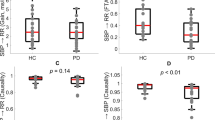Abstract
Patients with multiple system atrophy (MSA) often have clinically significant postprandial hypotension (PPH). To elucidate the cause of insufficient cardiac preload augmentation that underlies PPH, we recorded calf venous capacitance (CVC) by strain-gauge plethysmography, in 17 MSA patients and eight healthy controls before and after oral glucose ingestion. Among 17 MSA patients, nine who showed a decrease in systolic blood pressure exceeding 20 mmHg and were diagnosed with PPH. MSA patients without PPH showed a significant decrease in CVC and a significant increase in cardiac output after oral glucose ingestion, as did controls; those with MSA exhibiting PPH showed a significant increase in CVC and no significant change in cardiac output. The change in CVC correlated positively with the decrease in systolic and diastolic blood pressure after glucose ingestion, and also correlated negatively with the increase in cardiac output. Physiologically, PPH is prevented by a decrease in venous capacitance, which increases circulating blood volume and cardiac output. In some MSA patients, failure of venous capacitance to decrease may induce PPH.






Similar content being viewed by others
References
Carraway R, Leeman SE (1973) The isolation of a new hypotensive peptide, neurotensin, from bovine hypothalami. J Biol Chem 248:6854–6861
Forconi S, Jageneau A, Guerrini M, Pecchi S, Cappelli R (1979) Strain gauge plethysmography in the study of circulation of the limbs. Angiology 30:487–497
Fu Q, Iwase S, Niimi Y, Kamiya A, Michikami D, Mano T, Suzumura A (2002) Age-related influences of leg vein filling and emptying on blood volume redistribution and sympathetic reflex during lower body negative pressure in humans. Jpn J Physiol 52:77–84
Gilman S, Low PA, Quinn N, Albanese A, Ben-Shlomo Y, Fowler CJ, Kaufmann H, Klockgether T, Lang AE, Lantos PL, Litvan I, Mathias CJ, Oliver E, Robertson D, Schatz I, Wenning GK (1999) Consensus statement on the diagnosis of multiple system atrophy. J Neurol Sci 163:94–98
Gladstone SA (1935) Cardiac output and related functions under basal and postprandial conditions. Arch Intern Med 55:533–546
Hakusui S, Sugiyama Y, Iwase S, Hasegawa Y, Koike Y, Mano T, Takahashi A (1991) Postprandial hypotension: microneurographic analysis and treatment with vasopressin. Neurology 41:712–715
Halliwill JR, Minson CT, Joyner MJ (1999) Measurement of limb venous compliance in humans: technical considerations and physiological findings. J Appl Physiol 87:1555–1563
Hirayama M, Ieda T, Koike Y, Takeuchi Y, Takeuchi S, Sakurai N, Hakusui S, Hasegawa Y, Takahashi A (1994) Pathophysiology of postprandial hypotension in patients with progressive autonomic failure (6)—comparison of gut peptide responses to oral intake of glucose and protein. Auton Nerv Syst 31:47–51
Hirayama M, Koike Y (1997) Pharmacological test. Nippon Rinsho 55(Suppl 1):491–493
Hirayama M, Watanabe H, Koike Y, Hasegawa Y, Kanaoke Y, Sakurai N, Hakusui S, Takahashi A (1993) Postprandial hypotension: hemodynamic differences between multiple system atrophy and peripheral autonomic neuropathy. J Auton Nerv Syst 43:1–6
Hirayama M, Watanabe H, Koike Y, Kanaoke Y, Sakurai N, Hakusui Y, Takahashi A (1993) Treatment of postprandial hypotension with selective alpha 1 and beta 1 adrenergic agonists. J Auton Nerv Syst 45:149–154
Hokanson DE, Sumner DS, Strandness DE Jr (1975) An electrically calibrated plethysmograph for direct measurement of limb blood flow. IEEE Trans Biomed Eng 22:25–29
Jansen RW, Lipsitz LA (1995) Postprandial hypotension: epidemiology, pathophysiology, and clinical management. Ann Intern Med 122:286–295
Lipsitz LA, Fullerton KJ (1986) Postprandial blood pressure reduction in healthy elderly. J Am Geriatr Soc 34:267–270
Mathias CJ, Bannister R (1999) Investigation of autonomic disorders. In: Bannister R, Mathias CJ (eds) Autonomic failure. A textbook of clinical disorders of the autonomic nervous system, 4th ed. Oxford University Press, pp 171–175
Mathias CJ, da Costa DF, Fosbraey P, Bannister R, Wood SM, Bloom SR, Christensen NJ (1989) Cardiovascular, biochemical and hormonal changes during food-induced hypotension in chronic autonomic failure. J Neurol Sci 94:255–269
Mathias CJ, Holly E, Armstrong E, Shareef M, Bannister R (1991) The influence of food on postural hypotension in three groups with chronic autonomic failure—clinical and therapeutic implications. J Neurol Neurosurg Psychiatr 54:726–730
Micieli G, Martignoni E, Cavallini A, Sandrini G, Nappi G (1987) Postprandial and orthostatic hypotension in Parkinson’s disease. Neurology 37:386–393
Norryd C, Dencker H, Lunderquist A, Olin T, Tylen U (1975) Superior mesenteric blood flow during digestion in man. Acta Chir Scand 141:197–202
Seyer-Hansen K (1977) Postprandial hypotension. Br Med J 2:1262
Smirk FM (1953) Action of a new methonium compound (M&B 2050A) in arterial hypertension. Lancet 1:457–464
Smith JJ, Kampine JP (1990) Blood and the ciuculation: general features. In: Smith JJ, Kampine JP (eds) Circulatory physiology, 3rd ed. Williams & Wilkins, pp 1–15
Stewart JM (2002) Pooling in chronic orthostatic intolerance: arterial vasoconstrictive but not venous compliance defects. Circulation 105:2274–2281
Svensson CK, Edwards DJ, Mauriello PM, Barde SH, Foster AC, Lanc RA, Middleton E Jr, Lalka D (1983) Effect of food on hepatic blood flow: implications in the “food effect” phenomenon. Clin Pharmacol Ther 34:316–323
Thomaides T, Bleasdale-Barr K, Chaudhuri KR, Pavitt D, Marsden CD, Mathias CJ (1993) Cardiovascular and hormonal responses to liquid food challenge in idiopathic Parkinson’s disease, multiple system atrophy, and pure autonomic failure. Neurology 43:900–904
Yokota T, Kamata T, Mitani K (1997) Postprandial cerebral ischemia. Stroke 28:2322–2323
Author information
Authors and Affiliations
Corresponding author
Rights and permissions
About this article
Cite this article
Takamori, M., Hirayama, M., Kobayashi, R. et al. Altered venous capacitance as a cause of postprandial hypotension in multiple system atrophy. Clin Auton Res 17, 20–25 (2007). https://doi.org/10.1007/s10286-006-0378-8
Accepted:
Published:
Issue Date:
DOI: https://doi.org/10.1007/s10286-006-0378-8




